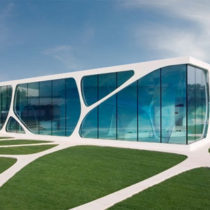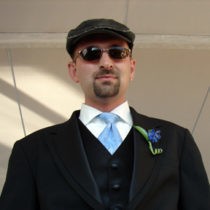Landscape Architecture for Landscape Architects › Forums › GENERAL DISCUSSION › Lets talk about Ideas again
- This topic has 1 reply, 4 voices, and was last updated 13 years, 4 months ago by
 Trace One.
Trace One.
-
AuthorPosts
-
March 6, 2012 at 4:42 am #158506
 Zach WatsonParticipant
Zach WatsonParticipantPersonally I have read and semi-followed some of the constant issues that always seem to be talked about on this forum. Issues of Unemployment, Respect, Understanding of the profession, lack of understanding by Clients, Office politics, and many other issues that just seem to degrade and pull down the moral of the profession.
I don’t know how anyone else feels but why don’t we start talking about ideas and projects and in the spirit of the article and last months LAM article ‘Frederick Law Olmsted is Holding Us Back’ (there is the Link if you haven’t seen the article) and start promoting current practicing Landscape Architects, which will help move our profession forward.
So if you have several minutes and take a look at this interview with MVV and see what you think.
March 6, 2012 at 2:43 pm #158520 Trace OneParticipant
Trace OneParticipantWow, thank you, the interview with MVV is outrageous..”A tyranny of flatness…” Nice!
as for how to elevate role of LAs good luck with that..
My own personal opinion is that we fail to engage attention because we refuse to seize the high ground with environmental design.. green landscape architecture…we could be at the forefront in designing the technical aspects of how to work with nature…
March 6, 2012 at 6:34 pm #158519 Zach WatsonParticipant
Zach WatsonParticipantWhile I agree with you to some degree, I see it as we don’t have to gain broad recognition from the general public. Yet we as an industry need to show to those we work with the high quality of work that we can do. People complain about how Architects are taking our jobs or other disciplines are taking our work, but if we look ourselves in the mirror, is the real problem that others are taking our work or is it that we are letting them take it by not being better at our own craft? Not only design but more importantly the ability to explain why it is important. Personally I believe it is the latter. To say that we want to green up a space is not a strong position.
It is for that reason I too believe that we need to start promoting our colleagues and talking about their work along with how and why it is important. Two things will happen, not only will we learn from each other but we will be able to show real meaning and value in what we bring to the table. Lets promote each other and move ourselves forward at the sametime.
March 6, 2012 at 9:05 pm #158518 Jeffrey Trojanowski,Participant
Jeffrey Trojanowski,ParticipantI believe “Green” Landscape Architecture is a moot point. What is more green than Landscape Architecture. The video is a prime example. Brooklyn Bridge Park took an industrial shipping yard (flat and full of concrete and steel buildings) and made it a lush landscape where people gather. MVV has beautified the area, created a gathering space, and the landscape (be it an extremely small part) is helping air quaility.
I really don’t understand the LEED movement in Landscape Architecture. I do not know one park that is USGBC LEED certified, because there are not enough buildings on a park to use low VOC paint, etc.
We do need to start promoting one another as a profession. It will help us in the long run. I read the article in LAM a couple days ago and I agree with it. If we don’t promote, who will? Architects…?
In Southern California, Melendrez has done a lot of work, but one that I have been to a couple times is the 9 acre LA Zoo Entry Renovation. They combined the entire makeup of Southern California and shrank it down into an entry plaza, from the foothill landscape to the dry stream beds of the arroyo. In doing this they used tumbled blue and green glass instead of gravel in their exposed aggregate paving to simulate this, and all of the parking islands are bio-swales.
March 6, 2012 at 9:29 pm #158517 Trace OneParticipant
Trace OneParticipantYour answer makes my point, Mr. Trojanowski..We are, as a profession, limited by our imaginations. Architects are trying to make buildings that work like cells, David Bryne is using buildings for musical instruments, and all we can think of is to make the swales in the parking lot bio-retentive..We need to open our minds and seize the frontlines of environmentalism. But half of the LA’s don’t even want to build to LEED standards.. And Harvard has come up with some silly contortion about ecological urbanism, which seems like the same old McHarg stuff to me..There seems to be so much room for new synthesis, instead of for old bio-swales..
March 6, 2012 at 9:47 pm #158516 Zach WatsonParticipant
Zach WatsonParticipantJeff, thank you for the post about this project, this is someone that I have not heard about. I am currently in my last semester at Arizona State and one of my goals after I graduate is to start a collection/blog of various LA projects. Almost like a critique but because I can’t visit all of the projects in person there will be things that I miss. I just feel that there are many very good LAs out in the world practicing that many within our own profession that we don’t know about and consequently are not able to learn from to improve our own design work. In school I have learned about the likes of Sasaki, Walker, MVV, McHarg, Eckbo, Kelley, Eliot, and a handful of others but there is little to no information about the current, practicing LAs because we focus so heavily on what has gone before us.
March 6, 2012 at 9:55 pm #158515 Zach WatsonParticipant
Zach WatsonParticipantTrace, while I find the work of Building Architects fascinating, their work is just different then ours. The elements that they work with inherently force them to create an experience where as for our work the elements themselves bring their own inherent experience. Now that does not mean that we can’t help create an experience with our projects but it’s just different. MVV in this clip even points out how the curves in pathways and the changes in elevation give visitors a very different experience that those that are found in the rest of the city.
I believe that our work and the work of Building Architects along with other designers are like various instruments in an orchestra that when playing and working together great great music is created but at the same time the violent and the oboe are very different.
March 6, 2012 at 11:03 pm #158514 Jeffrey Trojanowski,Participant
Jeffrey Trojanowski,ParticipantIt’s not that LA’s don’t want to build to LEED standards, they can’t.
There are only about 6 points available for LA’s when it comes to LEED certification of a project. 99% of the points have to do with, bathroom lighting, low VOC paint and glue for the linolium and carpet, natural light in rooms, etc.
There will always be room for new synthesis. It’s what we do with it as a profession that will define us.
March 7, 2012 at 12:28 am #158513 Trace OneParticipant
Trace OneParticipantwhat the heck is ‘Building Architects’ , Zach? And you seem insulated by your choice of location for graduate school..At UPenn, we had all working LA’s as design studio masters, and the whole program revolved around design studios..No ‘senior thesis’ – someone asked me about that the other day..What the heck is that? But I am surprised – my impression of Arizona is that it is very forward in the design department..
When I was at school, I had as studio masters John Coe (zoos), John Hanna (Hanna Olin), (he’s dead…he smoked over your drawings..) Ed Bye, Andropoggon (still kicking), – all these people were working LA;’s, …Why is your schooling so focused on the dead?
There are many LA’s working and trying hard to innovate….
March 7, 2012 at 2:58 am #158512 Tosh KParticipant
Tosh KParticipanti believe ‘building architects’ is the term often used to label the architects that focus on structures/buildings as opposed to landscape, some folks feel the name ‘landscape architects’ being used while the ‘building architects’ calling themselves ‘architects’ derogatory and/or condescending.
‘Senior thesis’ has been popular in colleges particularly the last 10 yrs or so as a way of pushing students to pursue ‘self guided research.’ Presumably this was to help students prep for graduate school (all disciplines). I’m pretty sure I couldn’t graduate without a thesis for my history degree. In engineering we had a “culminating project” which had a big chunk of research involved. It seems design is jumping on the proverbial band wagon.
March 7, 2012 at 3:16 am #158511 Tosh KParticipant
Tosh KParticipantKongjian Yu at Turenscape & Adrian Geuze at West 8 would be worthwhile to look into. Not just because of their ‘design’ work, but also for their understanding of what the built work can do socially, politically and culturally. I admire them for taking a deep interest in the relationship of the culture they live in with the built and unbuilt environment around them. Kongjian speaks of our work as the “art of survival” and the need for designers to help us understand how we ought to live with the natural processes around us and understand it in a haptic and communal manner.
Another writer I enjoy is Randy Hester, his book “Design fro Ecological Democracy’ is worth reading.
The engrained professional culture of ‘building architecture’ is an inward and self-referential one and the “outside-the-box” designers stand out as an anomaly, being able to market themselves as “pushing the boundary.” Never mind that responsible design in all likelihood would meet LEED standards.
In contrast LArch has always borrowed heavily in theory and science from related fields (land art, field ecology, environmental engineering, biology, hydrology, cartography, etc) and so the fashionable design topic of the day may be less ‘new’ or ‘exciting.’ Let’s face it LEED and even SS is not that groundbreaking. A more thorough understanding of precedents could help the education of new designers while helping understand the continued discourse in landscape design. Hearing of “green infrastructure” as the future from my colleagues in civil engineering who fail to recognize Olmsted’s work or the “reclaim industrial landscapes” folks not acknowledging PArc des Buttes Chaumont is depressing.
One thing I loved about our graduate program was that the conversation and joint studios with architectural historians, ‘building architects,’ planners and landscape architects with the occasional refugee from env sci and engineering taught us to appreciate the contributions each field makes to understanding and constructing the built environment (then we graduate and learn all over about budgets and contractors…).
to the list of the honored dead add Smithson. read Smithson.
March 7, 2012 at 6:03 am #158510 Zach WatsonParticipant
Zach WatsonParticipantThanks for the comments, let me clear a few things up because I may have mislead a little bit, based on your comments. I’m about to complete my Undergraduate Degree (BSLA), while I am the age of a Graduate student there were a few things I needed to take care of before I entered college. Also throughout my four years here at Arizona State we have had studio classes every semester with either current practicing LAs or Academic LAs as instructors, some of my past instructors have been Ken Brooks, Duane Blossom, Byron Sampson, and Charles Anderson. So we have learned quite a bit from current practicing LAs. While I feel like I have learned a lot I believe there is still room for improvement.
My point is more the fact that any time we look at the history of Landscape Architecture we always talk about a few select people (at least this has been my experience in school) who were instrumental in the progression of the profession. While they were and are important, the discussion doesn’t seem to talk much about current successful LAs, or maybe that is just my perception.
I guess more than anything else, even aside from school, I personally would like to see more discussion about ideas and projects then talking about how the economy sucks and we can’t get this or that, because in the end we as a profession shouldn’t wallow in the mud. There is just to much potential to improve the world around us, for us to have pity parties. I know I might come across as an unknowing and ambitious student who doesn’t understand how the world works, but I’m ok with that because just as Peter Walker has said, I may only take a client 30 or 50 or 75% of the way there to realize a dream but it is just that much more than what they would have achieved otherwise. (paraphrasing)
March 7, 2012 at 6:07 am #158509 Zach WatsonParticipant
Zach WatsonParticipantI guess in the end this is what I’m trying to promote in my little way.
“Great minds discuss ideas, average minds discuss events, small minds discuss people.”
– Eleanor Roosevelt
Lets be great people and talk about ideas.
March 7, 2012 at 6:17 am #158508 Zach WatsonParticipant
Zach WatsonParticipantThank you Tosh for that information I will look into the people/organization that you listed. I have been interested in West 8’s work for quite some time.
March 7, 2012 at 2:05 pm #158507 Trace OneParticipant
Trace OneParticipantYeah, I know..he was one of my faves..Despite his somewhat ‘flim-flam’ man overtalking of his projects, but they were still beautiful designs and drawings..and landscapes..
: (
-
AuthorPosts
- You must be logged in to reply to this topic.


